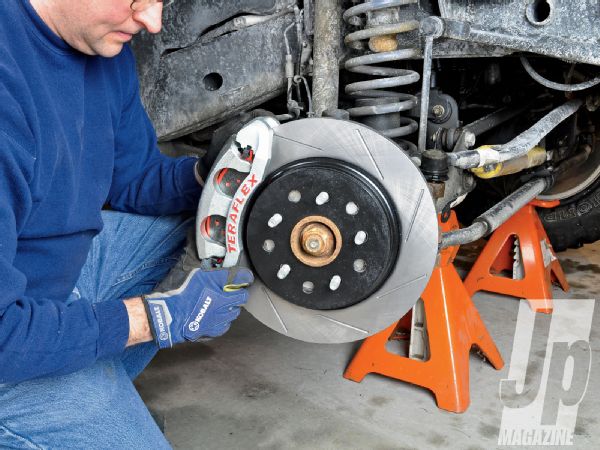
We are often weary of supposed bolt-ons, so the idea of a bolt-on brake kit scared us.

It's very common that off-the-shelf parts require the machining of something or changing additional parts to work correctly, and the brake system is not where you want to mess up. But after living with 35-inch tires on our '08 Jeep Wrangler Unlimited for about a year, we gave in to the temptation of an easy brake upgrade and decided to give the TeraFlex JK Big Brake Kit a try.
Bigger is better, but do you know why? There are three key reasons why larger brakes are better. The first is swept area, or the total surface area that the brake pads contact the rotor. Just like a larger tire patch on the ground means better traction, more pad on the rotor equals better braking power. The stock brakes provide 234.3 square inches of swept area; the bigger TeraFlex brakes provide 272.8 square inches. That's an increase of about 16 percent. Next is how far away the clamping action happens from the axle centerline. It's the same physics that make bolts easier to loosen with a 2-foot breaker bar compared to a 6-inch ratchet. The farther from the axle centerline that the pads ride on the rotors, the greater the stopping power. So larger diameter rotors equal more potential stopping force. Finally, the caliper can make a big difference. Essentially, a bigger caliper with larger pistons can squeeze harder, as long as the master cylinder can provide sufficient pressure and volume.
In addition to giving you improvements in all of these categories, this brake kit also includes performance pads. These have a friction material that is more aggressive, providing more grip on the rotor. The downside is that they can wear the rotors a bit quicker than stock, but TeraFlex feels that the material used gives you a happy medium between ultimate performance and longevity.
How's It Work
There is no proportioning valve to change on the '07-present Wrangler because brake pressure is managed through the factory computer. The ABS, ESP, brake traction control, and hill start assist are also unaffected by this upgrade. These systems will perform just like stock with the bigger brakes in place.
Once we bolted the bigger brakes onto our JK we did some before-and-after testing, as well as a seat-of-the-pants evaluation. We noticed two things right away. The first one isn't a positive-the brake pedal doesn't feel quite as firm as it did with the factory brakes. This is because it takes a lot more fluid to work the larger front calipers. The feeling isn't unacceptable, and the second thing we noticed makes it worthwhile-the initial braking action is much improved over stock. This is a bolt-on improvement that you can feel every time you apply the brakes.
To finish off our evaluation, we went to a secret Michigan testing facility and clicked off multiple before-and-after 60-0 mph tests. We applied full pressure to the pedal and let the ABS work to provide maximum pressure at the brakes. In stock form, the heavy Jeep stopped in an average of 125 feet. With the TeraFlex JK Big Brake Kit, our average fell to 108 feet, for almost a 15-percent improvement. That's a car length, which can be the critical distance you need to stay off the 6 o'clock news and return confidence in your braking power.
PhotosView Slideshow




